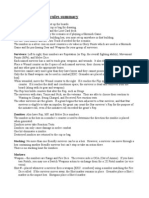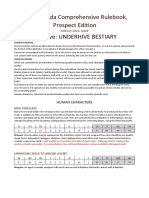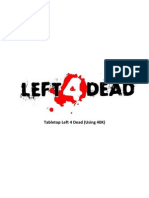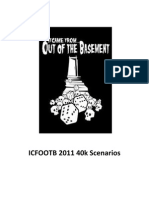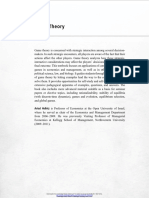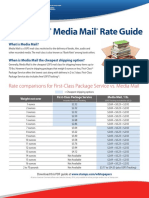ATZ Rules
ATZ Rules
Uploaded by
antonio carmona0 ratings0% found this document useful (0 votes)
37 views2 pagesThis document provides condensed rules for the board game ATZ: The Boardgame. It summarizes the key components of gameplay including playing pieces, sequence of play, movement, combat, reactions, and finding other survivors. The main elements are survivors and zombies moving and interacting on a hexagonal board, with turns involving initiative rolls, actions, ranged/melee combat, and zombie generation based on gunfire. Survivors can search buildings, scavenge gear, and potentially find new survivors to join their party.
Original Description:
Original Title
ATZ_rules
Copyright
© © All Rights Reserved
Available Formats
DOC, PDF, TXT or read online from Scribd
Share this document
Did you find this document useful?
Is this content inappropriate?
Report this DocumentThis document provides condensed rules for the board game ATZ: The Boardgame. It summarizes the key components of gameplay including playing pieces, sequence of play, movement, combat, reactions, and finding other survivors. The main elements are survivors and zombies moving and interacting on a hexagonal board, with turns involving initiative rolls, actions, ranged/melee combat, and zombie generation based on gunfire. Survivors can search buildings, scavenge gear, and potentially find new survivors to join their party.
Copyright:
© All Rights Reserved
Available Formats
Download as DOC, PDF, TXT or read online from Scribd
Download as doc, pdf, or txt
0 ratings0% found this document useful (0 votes)
37 views2 pagesATZ Rules
ATZ Rules
Uploaded by
antonio carmonaThis document provides condensed rules for the board game ATZ: The Boardgame. It summarizes the key components of gameplay including playing pieces, sequence of play, movement, combat, reactions, and finding other survivors. The main elements are survivors and zombies moving and interacting on a hexagonal board, with turns involving initiative rolls, actions, ranged/melee combat, and zombie generation based on gunfire. Survivors can search buildings, scavenge gear, and potentially find new survivors to join their party.
Copyright:
© All Rights Reserved
Available Formats
Download as DOC, PDF, TXT or read online from Scribd
Download as doc, pdf, or txt
You are on page 1of 2
ATZ: The Boardgame – Condensed Rules (ver. 1.
0)
1. Playing Pieces (counters)
a. Survivors
i. Stats: Reputation/Movement Points (MPs)/Melee Dice; Coin # = Glory Points
ii. Stars: Aren’t required to take Received Fire, Being Charged, or Wanting to Charge Reaction
Tests.
iii. Grunts: Grunts that are adjacent to Stars can activate along with the activated Star.
iv. Status Cards: Hold gear and provide info such as wound status and special abilities.
b. Weapons & Other Gear
i. Weapon stats: Range/Fire Dice; Coin # = Glory Points
ii. Scopes: Can be attached to all weapons except shotguns. Roll one additional 1d6 but doesn’t
add an additional shot marker.
iii. Drugs: Doesn’t require an action to use. The survivor’s initiative is increased by one for one
turn. Put the drug marker on the Rep Box as a reminder, then remove at the end of the turn.
iv. Medkit: Removes one wound from survivor (either self or adjacent survivor).
v. Vest: Wearers roll an extra 1d6 in Melee and other advantages described in the Ranged
Combat Table.
c. Zombies
i. Stats: Reputation/MPs/Melee Dice; Hex # = used for placement when generating zombies.
ii. Zombies only use melee combat
2. Sequence of Play
a. Generate Zombies: 1st turn only. Roll 6d6 per survivor; a roll of 4-6 generates a zombie and they are
placed per scenario rules.
b. Initiative Roll: Roll two 1d6 – one for survivors and one for the zombies. Highest roll goes first,
however, only those survivors/zombies whose Reputation is ≤ the die roll can take an impulse that turn.
c. Action Impulse:
i. Survivors can move and take one action. Those who end movement in a hex with zombies
must melee. Actions include:
1. Fire a ranged weapon (see 4.a)
2. Reload a weapon (see 4.a.v)
3. Use a piece of gear (see 1.b)
4. Search a building (draw a Loot card & place a Searched marker in the building)
5. Attempt to Fast Move (see 3.c.)
6. Switch weapons (see 4.a.iv.5)
7. Give gear or weapon to adjacent survivor – only if survivors aren’t in the same hex
as an enemy survivor or zombie.
ii. Zombies move toward closest survivor. They move in a straight line but will not enter a
building or a rough terrain hex unless a survivor is in the hex.
d. Zombie Generation: Roll 1d6 for each shot, indicated by a Shot marker, on the board. A roll of 4-6
generates a zombie. Pull zombies from a cup (CoZ) and place them in the direction indicated on the
zombies’ counter, six hexes from the shot marker. If this puts them off the board, place them on the
edge instead. Remove the Shot markers.
e. Move the Turn Marker forward one space: and start a new turn rolling for initiative.
3. Movement
a. Terrain: Movement is done hex-to-hex paying the appropriate MP cost per hex:
i. Clear: 1 MP
ii. Rough (woods & crops): 2 MP. Counts as Cover for Survivors vs. ranged-weapon fire.
iii. Buildings: 2 MP. Survivors must draw a zombie card unless the building has an Entered or
Searched on it. Take the number of zombies (from the CoZ) indicated on the card, and place
them in the building with the Survivor then determine if the survivor surprises the zombies.
The survivor rolls 1d6 and adds to his Reputation. Zombies roll 1d6 and add the number of
zombies in the hex. Highest score wins (ties go to the survivor).
1. Survivor wins: He can fire a weapon before melee or leave the building back to the
hex he entered it from.
2. Zombies win: Immediately enter into melee.
b. Stacking: Survivors may not end movement stacked together - except for enemy survivors and the
Professor. Any number of zombies may stack together.
c. Fast Move: Survivors may Fast Move by rolling 2d6 before they move. Each die that is ≤ the survivor’s
Reputation adds one MP to the survivors move for the turn. Fast Move is considered an Action and
survivors are always surprised if they enter a building.
4. Combat
a. Ranged-Weapon Fire:
i. Requirements
1. The survivor must have a weapon that is not out of ammo;
2. The target must be within the range listed on the weapon;
3. The target must be within Line of Sight (LOS)
ii. Procedure
1. Roll d6 equal to the weapon’s Fire Dice
2. Add each die to the Survivor’s Reputation
3. Consult the Ranged Combat Table (RCT).
iii. Multiple shots: Weapons with more than one Fire Dice can fire at more than one adjacent
target. Apply the higher dice to the first target and work your way down.
iv. Weapons
1. Submachine guns can fire 2-4 shots.
2. Assault rifles can fire 1-3 shots.
3. Shotguns roll 6 Fire Dice and choose the best three. Shotguns generate 6 Shot
Markers and all dice count for out of ammo checks.
4. Grenades can be thrown into an adjacent hex and can be in a pack, not in hand to do
so. Roll one Fire Dice for each target in a hex.
5. A survivor can carry two weapons, one in hand and one in pack. It costs one Action
to switch weapons.
v. Out of Ammo: When firing your weapon, you run out of ammo if you roll two or more 1’s.
Flip the weapon to it’s Out of Ammo side. You must spend one Action to reload unless you
discard an ammo counter – then it’s a free action.
vi. Panic Fire: Roll one additional 1d6, then flip the weapon to it’s out of ammo side after
resolving the attack.
b. Melee: Occurs whenever survivors are in the same hex as zombies or enemy survivors.
i. Procedure
1. The survivor rolls the number of dice equal to his Melee Dice on his counter and
compares to his Reputation; rolls of ≤ his Reputation is a success.
2. Zombies roll one die per zombie in the hex; rolls of ≤ 4 are successes.
3. Consult the Melee Table for the results.
5. Reaction
a. Being Charged Reaction Test: Taken after all zombies and enemy survivors have moved and are in a
survivor’s hex. Roll 2d6. Any die that is ≤ the survivor’s Reputation is a pass. Stars choose reaction.
Consult chart.
b. Runaway: If the survivor rolls a Runaway result, roll 1d6 to determine which direction the survivor will
run away using Fast Move. The survivor runs in a straight line and stop after using all of his MPs or
entering Rough terrain or a building hex.
c. Received Fire Reaction Test: Taken whenever a survivor if fired upon and the shots miss. Roll 2d6.
Any die that is ≤ the survivor’s Reputation is a pass. Stars choose reaction. Consult chart.
d. Duck Back: The survivor will move to cover either in a building or rough terrain or move to a hex where
the LOS is blocked between him and the shooter. No Fast Move allowed.
e. In Sight Reaction Test: Taken when an enemy survivor, for the first time, moves within 6 hexes of a
survivor and is in LOS. Roll 2d6. Any die that is ≤ the survivor’s Reputation is a pass. Taken by Stars.
Consult chart. Note: Survivors will keep firing at each other as long as they pass a Received Fire
Reaction Test, don’t run out of ammo, Duck Back out of sight, or Runaway.
6. Finding Other Survivors
a. See scenario rules for when a survivor might be found. If found, place in the same hex as the survivor
that generated her and randomly generate a weapon for her.
b. To determine if the discovered survivor is friendly, roll a 1d6 for each survivor and add the survivor’s
Reputation. If the player’s total is higher, the discovered survivor is friendly (and joins the party
controlled by the discovering player). The following modifiers apply for the player’s survivor:
i. +1 if the survivor’s are the opposite sex
ii. +1 if the player’s ready weapon is a shotgun, assault rifle, or SMG and the discovered survivor
is either armed with a pistol, double pistols, or crossbow.
c. Enemy survivors will melee and roll for initiative on subsequent turns.
d. Enemy survivors not in a hex with a zombie or survivor will fire on the closest zombie or survivor. If
out of ammo, she will attempt to charge the nearest zombie or survivor.
You might also like
- Bodaster's KDM Player Aid v1.6Document10 pagesBodaster's KDM Player Aid v1.6Renato MatosNo ratings yet
- All Things Zombie Rules Summary v1Document6 pagesAll Things Zombie Rules Summary v1amos_eva100% (1)
- Necromunda CriaturasDocument11 pagesNecromunda CriaturasAnonymous 0xxlG6100% (1)
- Bodaster's KDM Player Aid v1.7Document10 pagesBodaster's KDM Player Aid v1.7vampiri_venga_il_tuo_regnoNo ratings yet
- Top 10 Most Powerful Openings in ChessDocument12 pagesTop 10 Most Powerful Openings in ChessUrvoshi DuttaNo ratings yet
- Unisystem - Cinematic Unisystem PDFDocument2 pagesUnisystem - Cinematic Unisystem PDFJames ho100% (1)
- Star Wars - d20 - Revenge of The SithDocument23 pagesStar Wars - d20 - Revenge of The Sithdennis636223No ratings yet
- Training Matrix-Volleyball Girls ElemDocument6 pagesTraining Matrix-Volleyball Girls ElemHasmin lipang eniola80% (5)
- Sanctuary V1Document7 pagesSanctuary V1RomanNo ratings yet
- One Page Deadzone V0.5: by OnepageanonDocument2 pagesOne Page Deadzone V0.5: by OnepageanonMagus da BibliotecaNo ratings yet
- Deadly Skirmish Combat in A War-Torn Hive WorldDocument5 pagesDeadly Skirmish Combat in A War-Torn Hive WorldFrederic RougyNo ratings yet
- Tabletop Left 4 Dead v1Document16 pagesTabletop Left 4 Dead v1Jamie EdenNo ratings yet
- Big Board Portable Wargame: Modern: Unit Strength Points (SP) Type of Unit Strength Point Value RulesDocument4 pagesBig Board Portable Wargame: Modern: Unit Strength Points (SP) Type of Unit Strength Point Value Rulesnovalis angeNo ratings yet
- Metro 2033 RP Rules v0.18 (Change Notes at The Bottom)Document62 pagesMetro 2033 RP Rules v0.18 (Change Notes at The Bottom)Not Hunter100% (1)
- Skirmish WargamingDocument6 pagesSkirmish WargamingandyNo ratings yet
- Big Board Portable Wargame: Modern: Unit Strength Points (SP) Type of Unit Strength Point Value RulesDocument5 pagesBig Board Portable Wargame: Modern: Unit Strength Points (SP) Type of Unit Strength Point Value Rulesnovalis angeNo ratings yet
- Earthquake PDFDocument3 pagesEarthquake PDFpampicaNo ratings yet
- B/X Combat SequenceDocument2 pagesB/X Combat SequenceShantyNo ratings yet
- Warhammer 40k 8th Edition SummaryDocument1 pageWarhammer 40k 8th Edition SummaryAnonymous qXke00QUph97% (29)
- The Ninth CrusadeDocument9 pagesThe Ninth CrusadeAaron ThomasNo ratings yet
- Tyranid 5th EdDocument6 pagesTyranid 5th EdDeven CNo ratings yet
- Micromunda SkillsDocument1 pageMicromunda SkillsLoleNo ratings yet
- Duel Cheat SheetDocument2 pagesDuel Cheat SheetPhylosse StreamNo ratings yet
- Scenario 028 - Earthquake: TerrainDocument3 pagesScenario 028 - Earthquake: TerrainradzombieNo ratings yet
- Portable Wargame: Modern: Turn SequenceDocument3 pagesPortable Wargame: Modern: Turn Sequencenovalis angeNo ratings yet
- The Walking Dead - No Sanctuary - Rules Summary v1Document2 pagesThe Walking Dead - No Sanctuary - Rules Summary v1MatNo ratings yet
- DW - Special Abilities RefsheetDocument4 pagesDW - Special Abilities Refsheetfilios anestNo ratings yet
- Spectre Outer RimDocument7 pagesSpectre Outer RimMike GreenmanNo ratings yet
- Re Ordered Rules For Wreck of The BSM PandoraDocument6 pagesRe Ordered Rules For Wreck of The BSM PandorakirkhereNo ratings yet
- Mecha - Chapter 5 - CombatDocument12 pagesMecha - Chapter 5 - CombatsamuemullerNo ratings yet
- Big Board Portable Wargame: 19 Century: Unit Strength Points (SP) Type of Unit Strength Point Value RulesDocument3 pagesBig Board Portable Wargame: 19 Century: Unit Strength Points (SP) Type of Unit Strength Point Value Rulesnovalis angeNo ratings yet
- 40k Zombies - DBDocument15 pages40k Zombies - DBChris JonesNo ratings yet
- 1p40k - Main Rulebook v3.2.1 PDFDocument20 pages1p40k - Main Rulebook v3.2.1 PDFdartagan100% (1)
- 40k Zombies - DBDocument15 pages40k Zombies - DBThanh LiuNo ratings yet
- Dead GodsDocument4 pagesDead GodsJohn JunkNo ratings yet
- 1500 Savage + NGDocument3 pages1500 Savage + NGrogueSRANo ratings yet
- The Doomed QRSDocument2 pagesThe Doomed QRSdavidNo ratings yet
- 76 GugDocument2 pages76 GugIoannis PavlidisNo ratings yet
- House Rules (Labyrinth Lord)Document5 pagesHouse Rules (Labyrinth Lord)Chuck Thompson100% (1)
- 40K ScenariosDocument10 pages40K Scenariosdownload40kNo ratings yet
- Chinese TakeoutDocument30 pagesChinese TakeoutJeffNo ratings yet
- Big Board Portable Wargame: Modern: Unit Strength Points (SP) Type of Unit Strength Point Value RulesDocument5 pagesBig Board Portable Wargame: Modern: Unit Strength Points (SP) Type of Unit Strength Point Value Rulesnovalis angeNo ratings yet
- Portable Wargame: 19 Century: Turn SequenceDocument3 pagesPortable Wargame: 19 Century: Turn Sequencenovalis angeNo ratings yet
- Sellswords - Core Rules v0.24Document7 pagesSellswords - Core Rules v0.24Radosław SekułaNo ratings yet
- Zombicide Black Plague SkillsDocument1 pageZombicide Black Plague Skillsphiloking3850% (2)
- Combat Guide TestDocument2 pagesCombat Guide TestTeppo TestaajaNo ratings yet
- Dead Gods v1.3Document4 pagesDead Gods v1.3Villa JaasielNo ratings yet
- Character: 2. Resting (3 Times During Adventure) - Can Do 2x in RowDocument1 pageCharacter: 2. Resting (3 Times During Adventure) - Can Do 2x in RowVika PeluxNo ratings yet
- Pulp FireFightDocument1 pagePulp FireFightEduardoNo ratings yet
- Kill Teams v3.8Document49 pagesKill Teams v3.8Peter DarrouzetNo ratings yet
- Savage Worlds Adventure Edition - Combat Cheat SheetDocument1 pageSavage Worlds Adventure Edition - Combat Cheat Sheetdavid culhamNo ratings yet
- Big Board Portable Wargame: Modern: Unit Strength Points (SP) Type of Unit Strength Point Value RulesDocument6 pagesBig Board Portable Wargame: Modern: Unit Strength Points (SP) Type of Unit Strength Point Value Rulesnovalis angeNo ratings yet
- FAE JediDraftDocument6 pagesFAE JediDraftkratos58585No ratings yet
- VK1 - Doctors On The Run (Sanitarios A La Carrera)Document4 pagesVK1 - Doctors On The Run (Sanitarios A La Carrera)Pedro MagalhãesNo ratings yet
- Simplicity in HexesDocument7 pagesSimplicity in HexeselmitxelNo ratings yet
- Dead Gods v1.4Document4 pagesDead Gods v1.4fenrisNo ratings yet
- Dungeon BlitzDocument4 pagesDungeon BlitzBilly WalshNo ratings yet
- Marienburg Scenario 14 - Midnight at The MausoleumDocument2 pagesMarienburg Scenario 14 - Midnight at The MausoleumnazrukNo ratings yet
- Deadlands Combat Guide PDFDocument2 pagesDeadlands Combat Guide PDFstryke99No ratings yet
- OnePage Age of Fantasy Skirmish - Core Rules v2.5Document2 pagesOnePage Age of Fantasy Skirmish - Core Rules v2.5pedro100% (1)
- Combat Guide Savage WorldsDocument2 pagesCombat Guide Savage Worldsscreechingbint4118No ratings yet
- 1000 NG4 ShootersDocument3 pages1000 NG4 ShootersrogueSRANo ratings yet
- Bscpe and It Hand OutsDocument41 pagesBscpe and It Hand OutsFrancis QuintinNo ratings yet
- UESRPG 2e Supplement - Dark Paths (v1.1) PDFDocument14 pagesUESRPG 2e Supplement - Dark Paths (v1.1) PDFBumpybot123100% (2)
- Fritz 16 HelpDocument372 pagesFritz 16 HelpMuhammad Amirul Naim MasrosNo ratings yet
- The Hunger Games The Abridged ScriptDocument19 pagesThe Hunger Games The Abridged ScriptTanner AbdooNo ratings yet
- ManualDocument206 pagesManualSzántó LajosNo ratings yet
- Aviad Heifetz-Game Theory - Interactive Strategies in Economics and Management-Cambridge University Press (2012)Document484 pagesAviad Heifetz-Game Theory - Interactive Strategies in Economics and Management-Cambridge University Press (2012)ViAnh0% (1)
- TheAmaranth - Jasa Isi HD List FileDocument407 pagesTheAmaranth - Jasa Isi HD List Fileraynond kerenNo ratings yet
- The Blame GameDocument6 pagesThe Blame Gameapi-273018051No ratings yet
- Chapter 1 (Thesis)Document4 pagesChapter 1 (Thesis)Diane SernadillaNo ratings yet
- An Opening Repertoire For The Attacking Players PDFDocument169 pagesAn Opening Repertoire For The Attacking Players PDFIulian Bugescu100% (2)
- BNHS Action Plan Chess Club 2023 2024Document3 pagesBNHS Action Plan Chess Club 2023 2024Joel RiofloridoNo ratings yet
- Kinds of TV Shows/frequency AdverbsDocument2 pagesKinds of TV Shows/frequency AdverbsAnonymous laWo83fzNo ratings yet
- Game Theory For Strategic Advantage: Alessandro Bonatti MIT SloanDocument20 pagesGame Theory For Strategic Advantage: Alessandro Bonatti MIT SloanMarian VerdeNo ratings yet
- Two-Handed Is Superior To One-Handed BackhandDocument4 pagesTwo-Handed Is Superior To One-Handed BackhandFlorin Apanaghie0% (1)
- Arranged by Joanime Project, transcribed by Harry Zhang: Aimer 暖かく 暖かく = 66Document5 pagesArranged by Joanime Project, transcribed by Harry Zhang: Aimer 暖かく 暖かく = 66LeonidNo ratings yet
- The Burning Wheel Tests: Procedure GuideDocument3 pagesThe Burning Wheel Tests: Procedure GuideillithidsquidNo ratings yet
- Wargames Illustrated - 331Document108 pagesWargames Illustrated - 331Divine Wind 69No ratings yet
- Nallu Memorial - 1st International Open Fide Rapid Rating Chess Tournament 2024Document3 pagesNallu Memorial - 1st International Open Fide Rapid Rating Chess Tournament 2024ganesanbhuvanesh241003No ratings yet
- Alekhine's Defense, Alburt VariationDocument3 pagesAlekhine's Defense, Alburt VariationMaria Munster100% (1)
- Hindi Notes 12th STDDocument14 pagesHindi Notes 12th STDSiddhart ManotharaNo ratings yet
- Media Mail Rate GuideDocument2 pagesMedia Mail Rate GuidexiaojianNo ratings yet
- Manual "German Street Racing": IndexDocument7 pagesManual "German Street Racing": IndexaakkkiNo ratings yet
- Blank Dungeon Starters PDFDocument2 pagesBlank Dungeon Starters PDFIan McKeownNo ratings yet
- DDAL07-13 - Old Bones and Older Tomes v1.0Document38 pagesDDAL07-13 - Old Bones and Older Tomes v1.0Eduardo LibórioNo ratings yet
- RuneSlayers RevisedDocument251 pagesRuneSlayers Revisedtedehara80% (5)
- Magic Item Shopping: A DM's ResourceDocument16 pagesMagic Item Shopping: A DM's ResourceNo thanks100% (4)

